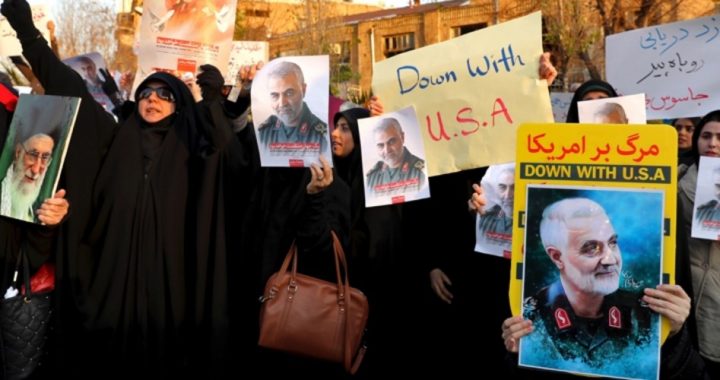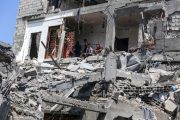
The immediate crisis appears to have passed in the wake of the January 3 U.S. surgical drone strike that took out Iran’s master terrorist, Gen. Ghasem Soleimani. Iran responded with predictable public bravado, along with an ineffective missile attack against military bases in Iraq that housed U.S. military personnel. Thankfully and wisely, President Trump chose to de-escalate the conflict, emphasizing that America had no desire for conflict with Iran.
But rest assured that for the hate-motivated leadership in Iran, the conflict has just begun. Once a radical Shi’a Muslim like Soleimani and the terrorist regime he served for decades, but now a follower of the “Prince of Peace” Jesus, I can tell you with certainty that Soleimani’s death at the hands of the U.S. military will not go unanswered. Hatred and retribution are at the heart of their radical Islamic ideology, and even now they are planning their revenge against innocent Americans.
The U.S. operates some 800 military bases around the world, and these bases, along with other U.S. installations, are prime targets for Iran’s retaliation. Of course, Iran is aware that its conventional forces are no match for America’s military might, so future retaliation will likely come via Iran’s proxies and terrorist groups strategically planted across the Middle East.
Through the far-reaching terrorist influence of Iran’s Quds Force personally commanded by Soleimani, Iran will have multiple theaters by which to attack U.S. interests and Americans. Remember that it was through one of those proxies, Hezbollah in Lebanon, that the U.S. Marine barracks at the Beirut airport was attacked in 1983 through a suicide truck bombing that killed 241 American military personnel — 220 of them brave U.S. Marines.
It would not take a great deal of effort for the Quds Force to injure and kill Americans. Recall that in October 2000, the USS Cole was at port in Aden, Yemen for refueling when it was attacked by a group of Al Qaeda suicide bombers in a small boat packed with explosives. The blast blew a gaping hole in the side of the 8,500-ton ship — and killed 17 U.S. sailors (although the goal was to kill everyone onboard).
These examples represent just two deadly attacks by one of the most well-established and insidious state-run terrorist organizations in the world. For those not well-versed on its commitment to domination by oppression and violence, a little historical background is in order.
Open Door to Terrorists
For the past 40 years, since its Islamic Revolution, Iran has been successfully spreading radical Shi’a ideology, establishing militias, terrorist groups, and other proxies throughout the Middle East, where there exists a substantial Shi’a population in such countries as Yemen, Lebanon, Syria — and, of course, Iraq, where 60 percent of the population are adherents to Shi’a Islam.
Specifically Iraq, where Soleimani was summarily dispatched in a well-planned U.S. drone strike, has become the main launching point for Iran’s expansion of Shi’a-inspired terror. Tehran has spent nearly two decades building up extensive networks among militia groups and politicians in Iraq.
The fall of Saddam Hussein in 2003 created a power vacuum in Iraq due to the dismantling of Iraq’s armed forced by U.S. troops. This opened the door to the violent Sunni insurgency targeting American troops as well as the Shi’a population. The minority Sunnis considered the majority Shiite population a threat, and the Sunni insurgency helped lead the rise of the Shi’a militants, who looked to Iran for support and leadership in a war-torn nation.
The Iraqi people needed security, and the majority Shi’a population turned to Iran for protection. Of course, Tehran was more than willing to oblige, and began a campaign of influencing Iraqi society by building Islamic religious sites, hospitals, and schools, as well as cultivating strong ties with high-level officials in Iraq. The withdrawal of U.S. troops from Iraq further fortified Tehran’s presence there, making Iraq a strong ally.
The Iranian Revolutionary Guard Corp (IRGC), with its Quds Force unit at the head, is the main Iranian liaison with Iraq and other Arab nations. The Quds Force has been identified as responsible for facilitating and empowering such terrorist entities as Hezbollah operating in Lebanon, Hamas and Palestinian Islamic Jihad in the Gaza Strip and the West Bank, Yemeni Houthis, and Shi’a militias in Iraq, Syria, and Afghanistan. Commanded by Soleimani until his own violent January 3 death, the Quds Force has undoubtedly been responsible for the murders of hundreds of American soldiers in Iraq. In April 2019 President Trump did what no previous president had done, officially designating Iran’s IRGC a terrorist group.
Since the fall of Saddam, IRGC’s influence has infiltrated every aspect of Iraq’s political, economic, and religious life. In fact, its dominance over Iraqi politics was clearly displayed when Iraq’s parliament voted two days after the death of Soleimani in favor of expelling American forces from Iraq, which has been a priority objective for Iran for years.
What Next?
While Iran’s January 7 missile attack was largely ineffective, with no U.S. military personnel killed or injured, the conflict is most certainly far from over. What Iran will do in the days and months ahead to avenge America’s justified killing of Soleimani remains to be seen. One thing is certain, however: Iran will not stop its deadly attacks, and will continue to do all it can to push American military presence out of Iraq and Syria. America and its forces are a big hurdle for Iran’s expansionism in the Middle East.
The last war in Iraq was beyond costly for the U.S., with $2 trillion dollars spent and over 4,500 American lives sacrificed — but to what end? What was accomplished aside from strengthening Iran’s position in Iraq? As the U.S. Army report on the Iraq conflict concluded: “An emboldened and expansionist Iran appears to be the only victor.”
With that in mind, what is the U.S. strategy following the killing of Iran’s top terrorist? Has America further emboldened Iran’s resolve to expand its terrorist impact across the Middle East? Have we raised more sympathy towards Iran’s regime from other radical groups and even some in the U.S. media? However America’s Middle East policy evolves over the months and years ahead, one truth remains: As long as Iran’s Ayatollah regime remains in power, there will be no peace in the Middle East, but rather a dreadful future of terror, death, and chaos.
The Only True Peace
As a pastor to millions of individuals in Iran through Nejat TV, I would be remiss in failing to note the good news of what is happening. In the midst of the oppression, violence, death, and darkness in Iran and across areas of the Middle East controlled by radical Muslim ideology, a new day is dawning in the hearts of untold millions, and the light of the Christian Gospel is shining brighter than ever before. The cruelty and oppression of the regime in Iran has created disdain in the hearts of millions of Iranians towards Islam and the Islamic Sharia law. And millions are seeking the love of God through the one and only Prince of Peace, Jesus Christ.
Ultimately, I believe that Jesus — His love and His lordship — is the only true and lasting solution to the chaos and misery we have witnessed in the Middle East for far too many decades. As a once radical Iranian Shi’a Muslim, I am convinced that if God can transform my heart and life through His compassionate hope and grace, there is, indeed, hope for anyone.
Photo: AP Images
Reza Safa, a former Iranian radical Shi’a Muslim, is now a Christian pastor, author, and director of TBN Nejat TV, an international television network that broadcasts Christian programming across Iran and the Middle East.



